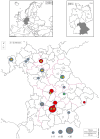Occurrence of Encephalitozoon cuniculi and Encephalitozoon hellem in European Wild Rabbits (Oryctolagus cuniculus) in Southern Germany (Bavaria)
- PMID: 39409829
- PMCID: PMC11475994
- DOI: 10.3390/ani14192880
Occurrence of Encephalitozoon cuniculi and Encephalitozoon hellem in European Wild Rabbits (Oryctolagus cuniculus) in Southern Germany (Bavaria)
Abstract
Encephalitozoon cuniculi and Encephalitozoon hellem are fungus-related, obligate intracellular pathogens belonging to the microsporidia. Both microorganisms occur in mammals, birds and even humans, thus revealing a zoonotic potential. Knowledge of their relevance in wild rabbits is very limited so far. Thus, the aim of the present study was to investigate the occurrence of E. cuniculi and E. hellem in wild rabbit populations in southern Germany (Bavaria). Therefore, blood and organ samples (brain/kidney) of 158 wild rabbits were investigated by immunofluorescence and PCR-based assays. Antibodies to E. cuniculi were detected in 24 of the 158 (15.2%) wild rabbits, while DNA of E. cuniculi was found in 7 (4.4%) and DNA of E. hellem was found in 3 (1.9%). Sequencing identified E. cuniculi genotype 1. This study provides the first E. cuniculi genotype determination in free-living wild rabbits worldwide and the first evidence of E. hellem in rabbits worldwide. Wild rabbits should, therefore, be regarded as a reservoir for both pathogens and, on the basis of molecular evidence from kidney tissue and presumed urine excretion, also as a source of infection for E. cuniculi for animals and humans.
Keywords: IFAT; Lagomorpha; PCR; microsporidia; wildlife; zoonotic.
Conflict of interest statement
The authors declare no conflicts of interest.
Figures

Similar articles
-
Zoonotic Microsporidia in Wild Lagomorphs in Southern Spain.Animals (Basel). 2020 Nov 26;10(12):2218. doi: 10.3390/ani10122218. Animals (Basel). 2020. PMID: 33256050 Free PMC article.
-
Molecular Detection of Microsporidia in Rabbits (Oryctolagus cuniculus) in Tenerife, Canary Islands, Spain.Biology (Basel). 2022 Dec 10;11(12):1796. doi: 10.3390/biology11121796. Biology (Basel). 2022. PMID: 36552305 Free PMC article.
-
More than a rabbit's tale - Encephalitozoon spp. in wild mammals and birds.Int J Parasitol Parasites Wildl. 2016 Jan 8;5(1):76-87. doi: 10.1016/j.ijppaw.2016.01.001. eCollection 2016 Apr. Int J Parasitol Parasites Wildl. 2016. PMID: 28560162 Free PMC article. Review.
-
Molecular Detection of Encephalitozoon cuniculi in Migratory Waterfowl of the Genus Anser (Anseriformes: Anatidae) in Poland.Pathogens. 2025 May 16;14(5):489. doi: 10.3390/pathogens14050489. Pathogens. 2025. PMID: 40430809 Free PMC article.
-
A multidisciplinary review about Encephalitozoon cuniculi in a One Health perspective.Parasitol Res. 2022 Sep;121(9):2463-2479. doi: 10.1007/s00436-022-07562-z. Epub 2022 Jul 16. Parasitol Res. 2022. PMID: 35840730 Free PMC article. Review.
Cited by
-
Comparative Evaluation of the Serological Methods and the Molecular Genetics Techniques for the Diagnosis of Encephalitozoon cuniculi in Rabbits (Oryctolagus cuniculus).Microorganisms. 2025 Jun 25;13(7):1478. doi: 10.3390/microorganisms13071478. Microorganisms. 2025. PMID: 40731986 Free PMC article.
References
Grants and funding
LinkOut - more resources
Full Text Sources

